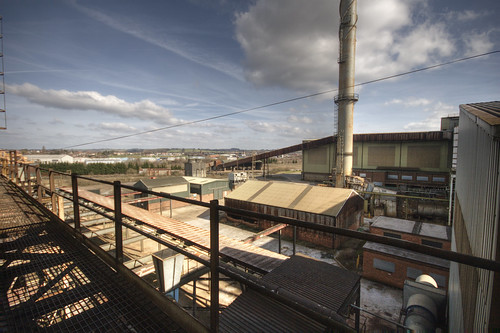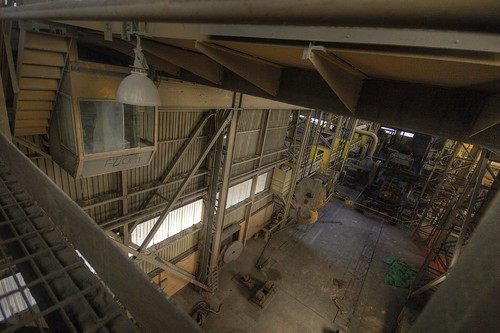Production at Stanton Ironworks in Ilkeston drew to a close when the last pipe was cast on May 24, 2007.
The last of the 185 production workers at the pipe-making factory walked out of the gates for the final time.
http://www.flickr.com/photos/fieldym/3804075570/

Stanton Ironworks was once Ilkeston's largest manufacturing concern and consequently the town's biggest employer of local labour in the area.
The Stanton and Staveley group was also part of the British Steel Corporation, forming part of its Tubes Division.
At its height, the company employed around 12,500 people of which 7,000 worked at the Stanton works.
http://www.flickr.com/photos/fieldym/3803250037/

Over the years the company has produced a vast range of products.
Spun iron pipes, pig iron, pre-stressed concrete pipes, street furniture, lighting columns and cast-iron tunnel segments, used in the construction of the London Underground and the Mersey Tunnel.
Other by-products included chemicals, coke oven gas, bitumen and road-stone.
It was also a vital producer of artillery shells in both world wars.
http://www.flickr.com/photos/fieldym/3804069522/

The origins of the Stanton Ironworks start 1846 when Chesterfield man, Benjamin Smith and his son Josiah, brought three blast-furnaces into production alongside the banks of the Nutbrook Canal.
This is usually where I place an of the wall comment which derails the text into some irreverant speil about Horses or Indiana Jones.
Between 1865 and 1867, Benjamin Smith's original three furnaces were replaced with five new furnaces.
This site becoming known as the Old Works. Smith's furnaces produced about 20 tons of pig iron per day but the company soon experienced financial difficulties and there followed a series of take-overs during the middle of the 19th century.
http://www.flickr.com/photos/fieldym/3803265817/

During this period the business was taken over by the Crompton family.
This family owned the company for over eighty years, re-naming the works: The Stanton Iron Company.
Boring isn't it, without the stupidity.. Its just words copied from a website.
The Franco-Prussian War of 1870 created a huge demand for iron and the works expanded rapidly with the construction of new furnaces and foundries (the New Works) alongside the Erewash Canal in the early 1870s.
Admit it, this is boring, to be honest I wouldn't be reading this. Just scroll past the big sections of words and click nice pics and that.
By the early 20th century the business was named The Stanton Ironworks Company Ltd.
The company was eventually taken over by Stewarts and Lloyds Ltd and was merged with the Staveley Iron and Chemical Company Ltd in 1960 to form Stanton and Staveley.
Serious, it never stops.. I found loads on this place. You could have gone to google and got all this.. Its just plagarism at its best.
When in 1967 Stewarts and Lloyds became part of the nationalised British Steel Corporation, its major subsidiary - Stanton and Staveley - was also incorporated.
http://www.flickr.com/photos/fieldym/3803247351/

During the Great War War of 1914-1918 Stanton produced large numbers of shell casings, while during the conflict of 1939-45, both shell and bomb casings, gun barrels, and concrete air-raid shelter components were produced.
You think I would have stopped by now but no.. All this text is lifted straight from stantonironworks.co.uk I recomend you visit.
With its experience in high quality concrete products, Stanton was also involved with the production of experimental concrete torpedo casings.
During the Second World War, the Stanton Gate Foundry (known to later generations as the Erewash Foundry) produced 873,500 bomb casings
The years following the war saw Stanton's fortunes fluctuate with nationalisation, privatisation and re-nationalisation taking place.
Nearly done now, I promise.
During the early 1980s Stanton became part of the French Pont-a-Mouson Group and later part of Saint Gobain.
Today most of the site has beem demolished and gone. Most of the remainder of what is still standing is now derelict and it is belived that it will soon be scheduled for demolition.
Today, Fieldy has bored you to sleep and stolen your wallet!
The last of the 185 production workers at the pipe-making factory walked out of the gates for the final time.
http://www.flickr.com/photos/fieldym/3804075570/

Stanton Ironworks was once Ilkeston's largest manufacturing concern and consequently the town's biggest employer of local labour in the area.
The Stanton and Staveley group was also part of the British Steel Corporation, forming part of its Tubes Division.
At its height, the company employed around 12,500 people of which 7,000 worked at the Stanton works.
http://www.flickr.com/photos/fieldym/3803250037/

Over the years the company has produced a vast range of products.
Spun iron pipes, pig iron, pre-stressed concrete pipes, street furniture, lighting columns and cast-iron tunnel segments, used in the construction of the London Underground and the Mersey Tunnel.
Other by-products included chemicals, coke oven gas, bitumen and road-stone.
It was also a vital producer of artillery shells in both world wars.
http://www.flickr.com/photos/fieldym/3804069522/

The origins of the Stanton Ironworks start 1846 when Chesterfield man, Benjamin Smith and his son Josiah, brought three blast-furnaces into production alongside the banks of the Nutbrook Canal.
This is usually where I place an of the wall comment which derails the text into some irreverant speil about Horses or Indiana Jones.
Between 1865 and 1867, Benjamin Smith's original three furnaces were replaced with five new furnaces.
This site becoming known as the Old Works. Smith's furnaces produced about 20 tons of pig iron per day but the company soon experienced financial difficulties and there followed a series of take-overs during the middle of the 19th century.
http://www.flickr.com/photos/fieldym/3803265817/

During this period the business was taken over by the Crompton family.
This family owned the company for over eighty years, re-naming the works: The Stanton Iron Company.
Boring isn't it, without the stupidity.. Its just words copied from a website.
The Franco-Prussian War of 1870 created a huge demand for iron and the works expanded rapidly with the construction of new furnaces and foundries (the New Works) alongside the Erewash Canal in the early 1870s.
Admit it, this is boring, to be honest I wouldn't be reading this. Just scroll past the big sections of words and click nice pics and that.
By the early 20th century the business was named The Stanton Ironworks Company Ltd.
The company was eventually taken over by Stewarts and Lloyds Ltd and was merged with the Staveley Iron and Chemical Company Ltd in 1960 to form Stanton and Staveley.
Serious, it never stops.. I found loads on this place. You could have gone to google and got all this.. Its just plagarism at its best.
When in 1967 Stewarts and Lloyds became part of the nationalised British Steel Corporation, its major subsidiary - Stanton and Staveley - was also incorporated.
http://www.flickr.com/photos/fieldym/3803247351/

During the Great War War of 1914-1918 Stanton produced large numbers of shell casings, while during the conflict of 1939-45, both shell and bomb casings, gun barrels, and concrete air-raid shelter components were produced.
You think I would have stopped by now but no.. All this text is lifted straight from stantonironworks.co.uk I recomend you visit.
With its experience in high quality concrete products, Stanton was also involved with the production of experimental concrete torpedo casings.
During the Second World War, the Stanton Gate Foundry (known to later generations as the Erewash Foundry) produced 873,500 bomb casings
The years following the war saw Stanton's fortunes fluctuate with nationalisation, privatisation and re-nationalisation taking place.
Nearly done now, I promise.
During the early 1980s Stanton became part of the French Pont-a-Mouson Group and later part of Saint Gobain.
Today most of the site has beem demolished and gone. Most of the remainder of what is still standing is now derelict and it is belived that it will soon be scheduled for demolition.
Today, Fieldy has bored you to sleep and stolen your wallet!



